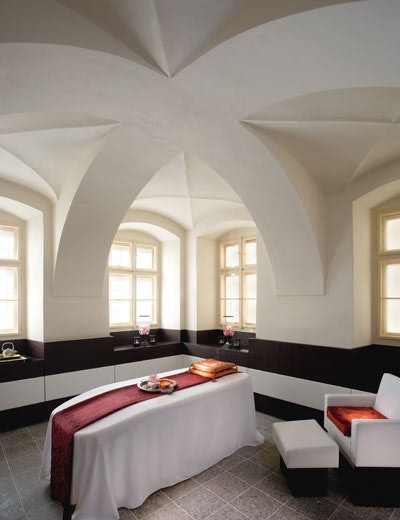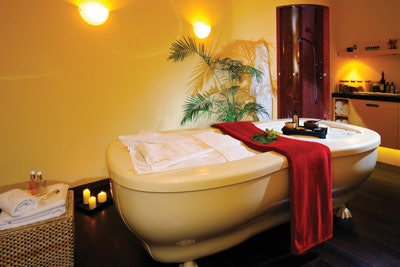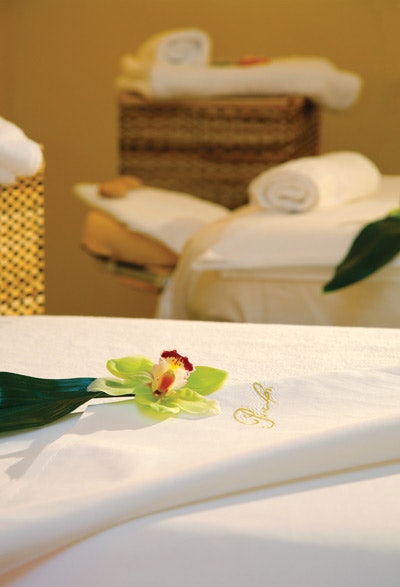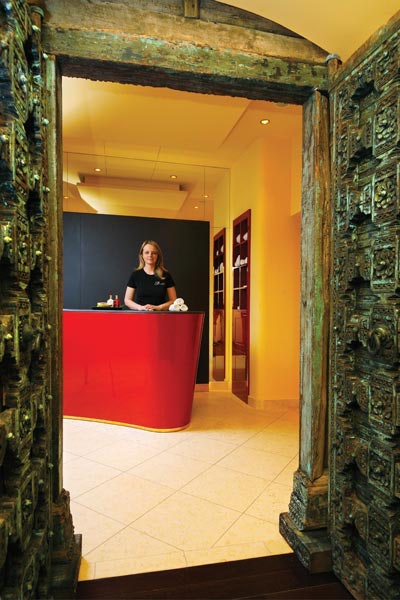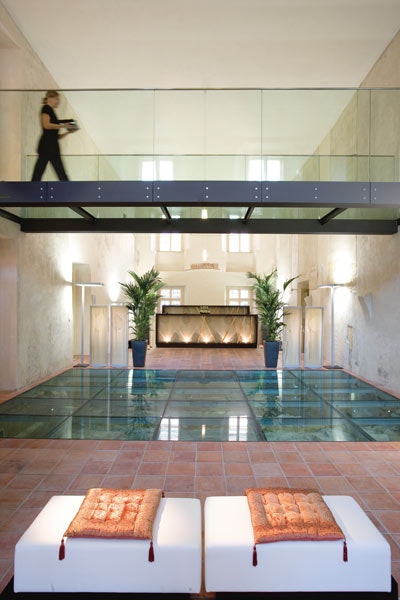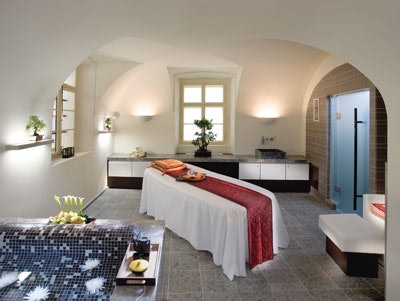
For several years, my well-traveled friends have been exclaiming about the city of Prague. They rave about the architecture, the food, the fun. “Best city in Europe!” they often declared after visiting. So when I booked my recent trip to the Czech capital, with plans to experience Pure Spa at the Hotel Le Palais Prague and the Spa at Mandarin Oriental, Prague, I was unsure if the city could possibly live up to the hype. Turns out, it did—and then some.
Prague is a delight, in large part because it was spared the bombs and other ravages of World War II. As a result, it offers a stunning variety of architecture—soaring Gothic spires, curved baroque domes, elegant Art Nouveau influences and modern Cubist façades. And it’s a city made for walking. Manageable in size, it’s possible to stroll along the lanes of the Old Town and through the wooded parks while covering a majority of this medieval jewel on foot. The 14th century Charles Bridge spans the Vltava River and connects the Old Town and Malá Strana. Rimmed with oil lamps and adorned with more than 30 statues, by day this stone Gothic structure is a sunny social hub while at night it becomes almost mystical, shrouded in mist that seems to hide specters from bygone centuries.
Prague’s history is rich: It has been the capital of the Holy Roman Empire, the Hapsburg Empire, the first Czechoslovak Republic, the Nazi Protectorate of Bohemia and Moravia, the Communist Republic of Czechoslovakia, and the modern and democratic Czech Republic. And each left a mark on the city, including the spa heritage bestowed by the ancient Romans.
Today, Prague is a hopeful, prosperous place. The city is surprisingly affordable—prices are considerably lower than in other European capitals—and the quality of the lodging, food, shopping and so on is equal to anything you would find in Paris, London or Rome. And it’s fun. The cultural scene is quite lively—Bohemians and Moravians are passionate about music, art and literature, and are proud to claim writer Franz Kafka and composer Antonin Dvorak, among others, as native sons. Additionally, the cuisine is varied and delicious. I experienced extraordinary food and wines everywhere I dined. There are elegant shopping malls and chic cocktail bars galore, along with opera, ballet, drama, smoky jazz cellars and dance clubs.
After a few days exploring the city, I was eager to discover how the vast variety of cultural and historical influences of Prague would influence the spa experience.
Gothic glamour
Five minutes from the Charles Bridge and hidden in the quiet cobblestone streets beneath Prague Castle, the Mandarin Oriental, Prague was once a Dominican monastery. It has been successfully converted into a high-end, modern hotel with first-class comforts and amenities, yet at the same time retains its historic heritage and charm. In fact, many guests enjoy an hour-long tour of the hotel with the staff pointing out artifacts and elements of the original historic building. The beautiful, gated, arched entry sets the Gothic tone, while the cheerful palette of the interior keeps the overall ambience light and bright. There are intimate meeting and dining areas, large windows that open to a beautiful courtyard, and rooms that are incredibly spacious by European standards.
The Spa at Mandarin Oriental, Prague was situated in the basement, and when I heard that, I worried it would carry all of the negatives of a subterranean setting. I was wrong. In fact, it was one of the most extraordinary facilities I have ever seen.
The private spa elevator deposits guests at the end of a long hallway, where each side is lined with Czech antiquities and artifacts providing a rich flavor of the city’s culture and heritage. At the end of the hallway, inside the spa, all dank associations to basements are banished. The reception area is open, bright, high-ceilinged and spacious.
And there is a most extraordinary feature. During the restoration of the hotel, ancient remnants of a Gothic church were discovered beneath the site—the Church of St. Mary Magdalene. This church was built sometime in the early 1300s and was destroyed in the early 15th century during the Hussite wars. The findings were left intact and the spa was built around them. Today the spa’s foyer features a glass floor that allows visitors an unobstructed view of the remains that were uncovered.
Within the spa’s interior, one side is a peaceful relaxation area, blocked off by beautiful screens and designed for pre- and post-treatment lingering. The screen strategy preserves the basic structure of the space while utilizing valuable square footage, and guests waiting for services are encouraged to help themselves to a variety of waters and teas before retiring into private changing rooms for women and men.
The journey from changing room to treatment room takes visitors through another beautiful corridor featuring arched Gothic ceilings, which are also found in the spacious treatment chambers. The décor in my room featured cream-colored walls, light stone floors and a large soaking tub tiled in bright orange and yellow Italian tiles in the adjoining private bathroom. There also were large windows that let in plenty of natural light. As with the rest of the spa, the light, bright palette prevented the space from feeling dim or ponderous.
For my treatment, I elected to receive the Deep Tissue Massage, which is priced at $275 for 120 minutes, and the first thing I noticed was the large, modern, electrically heated treatment bed. It was more than adequate for my 6'5" frame, and it helped to relax my tense muscles in no time, making the entire massage experience soothing and comfortable.
My male therapist was strong and clearly experienced. After I told him my body was stiff and sore from my 31-hour journey to Prague, he combined a number of manipulations for my treatment, and it was clear he had a highly sophisticated understanding of anatomy. He was also extremely businesslike—after working on me for 90 minutes, he straightened up, announced, “We’re done now,” and left the room. Efficient and completely no nonsense.
As for the takeaways, without a doubt, the most impressive aspect of this spa was the skillful blending of the historical and cultural components of the city and hotel with a highly effective and luxurious modern spa experience. The thick walls and vaulting contributed to the coziness of the facility, while the soft colors and natural light prevented the sanctuary from feeling closed-in. Equally impressive was the clever use of space that provided the utmost privacy for each guest at all times. And of course, from the therapist to the support staff, the quality of my treatment and overall experience was unparalleled and consistent with the high standards I have come to expect from every spa in the Mandarin Oriental collection.
Unpretentious luxury
The Le Palais Hotel Prague is a charming boutique hotel with 72 individually designed guest rooms. It was built as a residential palace in 1897—a relatively new structure by Prague standards. It’s one of the city’s finest examples of Belle Epoque architecture, which was marked by beautiful neoclassical and curvilinear Art Nouveau facades, and it’s located in an exclusive residential area a short walk from the famous Wenceslas Square and the National Museum. Although it reopened as a hotel in 2002 after a complete refurbishment, it still retains all of the elegance and grace of the late 19th century.
The interior combines the heritage of the building with state-of-the-art style and attention to detail. For that reason, it enjoys a loyal clientele of sophisticated tourists and international business travelers, many of whom check in for extended stays.
The hotel’s Pure Spa is popular not only with Le Palais guests, but is also visited regularly by residents of the area—an ideal situation for a hotel spa. In fact, according to the spa director, it was guests and neighbors who pressed Le Palais to build the spa and adjoining health club with gym, sauna, steam bath, whirlpool and aroma showers. The hotel’s management wisely incorporates spa treatments into many of its packages, and consumer review sites rave about the facility.
Like the Spa at the Mandarin Oriental, Pure Spa is also located in the basement of the hotel, and its pale yellow walls and bright floral tiled mosaics make the facility cheery and bright. One of the most unusual features of Pure Spa is the fact that the treatments incorporate the customizable, aromatherapeutic Ligne St. Barth products into their treatments. Although at first I questioned the choice of this Caribbean-themed collection in a spa in a traditional European city, it soon became clear that these high-quality products added a delightful tropical flavor to this elegant place.
Pure Spa offers a variety of treatments for couples, so my friend Angelika and I decided to book the two-hour, Pure Spa Couple Treatment Experience. All of the couples treatments take place in a spacious treatment suite, a soothing, private room that easily accommodates two people and two therapists. The Pure Spa Couple Treatment, which costs $550, combines exfoliation, hydration and massage using pure St. Barth plant oils that guests customize with their own choice of aromatherapy additives. I chose a geranium-infused blend for its uplifting properties, and Angelika opted for a blend with strong rose notes to hydrate and relax.
As soft music played, the therapists began with a body-peeling massage employing fresh papaya, natural yogurt and a special sea-sand polish. The exfoliation was followed by the application of a luxurious, hydrating body mask, and ultimately, the therapists performed a relaxing massage that ensured a thorough penetration of the mask preparation, and left us utterly and completely relaxed. Every step of the treatment was performed in tandem, and the therapists finished at precisely the same moment—a dramatic and delightful detail.
After our treatment, we each showered in the en suite bathroom, and then sipped custom-blended teas in a private relaxation area. The treatment left us feeling completely refreshed and relaxed, and our skin looked and felt polished and supple. The spa director told us regular hotel guests are as loyal to the spa as they are to the hotel—30% of hotel guests use the spa, and though the usual conversion rate is just 6%, given this spa’s rich offerings and practiced treatments, it was really no surprise whatsoever.
Thanks to its location and ability to strike the right balance between great service and an unpretentious neighborhood atmosphere, Pure Spa has achieved the best of both worlds for a hotel spa. It’s a cozy, elegant destination spa for travelers and hotel guests, and at the same time, has become the neighborhood facility of choice for nearby residents. Certainly this is due, in part, to the high number of returning business travelers, but it must also be attributed to the high level of service and welcoming atmosphere there. Additionally, details such as the unique, Caribbean-themed Ligne St. Barth products and the perfectly synchronized couple’s treatments lift Pure Spa out of the realm of the ordinary, providing an experience that is truly unique.
A history of luxury
Americans are spending their money carefully nowadays, and for many, an extraordinary spa treatment might be substituting for a full-fleshed vacation this year. I believe this presents spas with an opportunity to emulate these Prague spas by stressing the unique—whether it’s emphasizing indigenous culture or introducing products and treatments that evoke faraway, exotic places. Along with consistent and excellent service in a welcoming environment, clients can find a delightful alternative to the travel plans that may be on hold in the current economy right in their friendly neighborhood spas.
